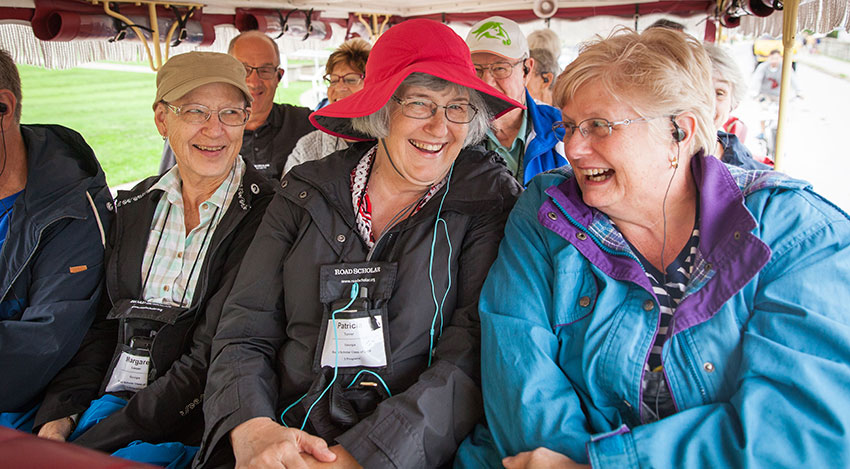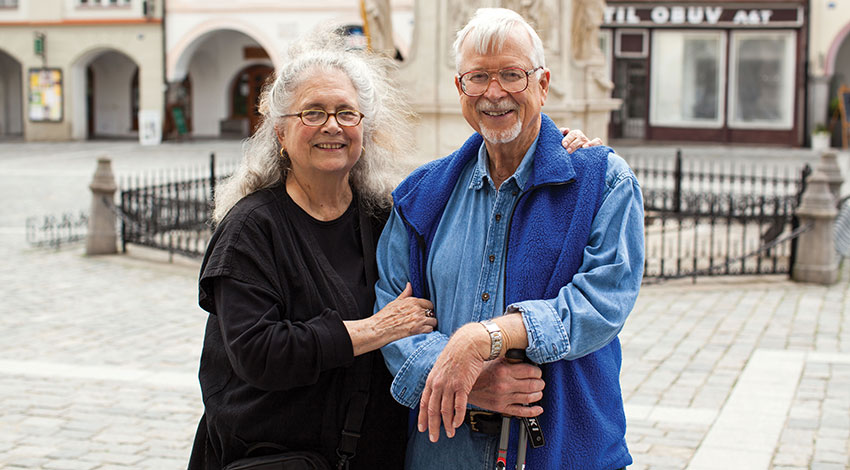Accessible Travel for Retirees: A Guide to Stress-Free Adventures
Explore the World with Comfort & Ease - A Road Scholar Guide
If you’re looking for vacation ideas for seniors with limited mobility, you’re in the right place. At Road Scholar, we have an expansive selection of vacation ideas for seniors who might need to take things a little slower. In this guide, we walk through travel tips for seniors, the top destinations to consider and more, so you can have a safe and memorable journey.

Choosing the Right Travel Experience
When it comes to travel tips for seniors, carefully choosing the right travel experience is crucial to ensuring comfort and safety. At Road Scholar, we have an expansive library of experiential learning programs designed for various interests, paces and ability levels. Curious about your options? Take a look at some of the top vacation ideas for seniors with limited mobility:
- Easy Going: Our Easy Going collection keeps things light while providing an enriching learning experience, making stops at museums, bringing you to a watercolor workshop or attending a theater festival. With ample breaks and a slow pace, this collection is perfect for seniors looking for a calming travel experience.
- On Your Feet: With light walking, our On Your Feet programs include gentle strolls down museum hallways or along pristine beaches at a comfortable pace.
- Keep the Pace: If you’re looking for a faster-paced adventure with plenty of excitement, Keep the Pace programs include everything from walking historic neighborhoods to sailing along coastlines.
- Let’s Go: As our most energetic collection of learning programs, Let’s Go tours can include several miles of walking cobblestone streets in Europe or full days exploring on foot.
- Outdoor: No Sweat: Interested in an easy outdoor adventure? Our No Sweat programs are perfect. These programs immerse you in nature without added effort — stop and snap a photo, pull over to smell some flowers or slowly snorkel through a calm coral reef without the intensity.
- Outdoor: Spirited: Take things up a notch with our Outdoor Spirited collection, which includes hiking, biking and kayaking adventures that get the heart pumping.
- Outdoor: Challenging: As our most invigorating collecting, our Outdoor Challenging tours are designed for energetic learners not scared to put in a 60-mile bike ride or navigate switchbacks up a mountain.
If travelers have specific issues or questions, Associate Vice President Participant Experience at Road Scholar Lucy McClelland suggests that they get in touch directly with the company.
“Any time a participant has questions about whether they can manage the activities on a program, they should call us,” she says. “If they explain their situation and concerns, the Support Team will work with the Programs Team on how suitable the program is for that participant. We will work to identify any activities that may be challenging and if reasonable accommodations can be made on that program.”

Tips for Traveling with Limited Mobility
Travel for seniors tours allows explorers of all ages and mobility levels to gain access to the world. It can be daunting when thinking about a trip, especially if it’s overseas in an unfamiliar territory. However, joining tours designed specifically for seniors at a slower pace ensures you’re comfortable and safe every step of the way. As you prepare for your latest adventure, keep these travel tips for seniors in mind:
- Pack light and hands-free: Traveling light can help reduce strain and make mobility much more manageable, allowing you to easily navigate airports and hotels. As a senior, you should prioritize lightweight, rolling suitcases and crossbody bags that enable you to stay hands-free to access support or assistive devices. Packing cubes can also help organize your travel necessities to access essentials without strain.
- Use assistive devices: Taking advantage of assistive devices, such as a folding cane chair or mobility scooter, can provide stability and a convenient place to sit after a day on your feet, exploring landmarks and museums or when waiting in line for attractions. As you prepare for your trip, check in with your airline and hotel, along with any planned restaurants or attractions, on the accessibility options they have available.
- Be sure to get the right accommodations: Booking accessible accommodations is crucial for a comfortable trip. When booking lodging, consider ground-floor rooms or those with elevator access, walk-in showers with grab bars, wide doorways for wheelchairs and walkers, and proximity to public transportation and planned attractions.
- Plan ahead: One of the most important travel tips for seniors is taking time to plan your vacation well ahead of time. Not only will you be able to plan your itinerary to suit your mobility needs, but you can often score better prices on transportation, lodging and attractions. When planning, contact restaurants, hotels and attractions to request wheelchair access if needed and book direct flights to reduce transfers and walking distance at airports.
- Travel with a support system: There’s nothing better than discovering new parts of the world with the people you love. When exploring vacation ideas for seniors, consider traveling with family, a friend or a guided group, which not only offers companionship and socializing opportunities but extra assistance if needed.
You aren’t alone if you’re worried about traveling with a group at an older age with limited mobility. Jane Carroll of Silver Spring, Maryland, was “scared to death to hold up everyone else,” so she went on a Road Scholar trip to the Alps at a slower pace prior to her knee replacements. Now, she is planning a program in Spain at a slower pace, as well as a journey to the Scottish Highlands this year. Travel for seniors is made easy at Road Scholar, as we have a large selection of experiential learning programs at a slower pace to accommodate all lifelong learners.

Best Places to Travel With Limited Mobility
Travel for seniors with limited mobility doesn’t have to be a challenge. Across the globe, there are exciting vacations for mobility-challenged travelers, offering them the opportunity to explore new areas of the world in an accessible way. When it comes to travel for those with limited mobility, seeking out train tours, bus tours and guided tours is an excellent way to view attractions and landmarks without obstacles like stairs, hills and other challenges along the way. Take a look at some of the top vacations for disabled seniors below:
1. National Parks (US & Canada)
Many of America’s national parks are excellent options for travel for elderly and disabled adventurers. Throughout the country, you can find national parks that don’t require extensive travel or long flights or drives. On the West Coast, popular parks include Yosemite, Yellowstone, Olympia and Joshua Tree National Parks. Here, visitors can find wheelchair-accessible boardwalks, scenic drives and easy access points to enjoy panoramic views and spot iconic landmarks like Half Dome in Yosemite or the Old Faithful geyser in Yellowstone.
On the East Coast, Acadia National Park in Maine offers a beautiful drive along Park Loop Road, a 27-mile route that circumnavigates the park with stops along the coast and wooded forests. The Great Smoky Mountains are another great option for limited mobility travel, with accessible restrooms at visitor centers, designated handicapped parking spots, wide paths with hard-parked gravel and wheelchair-accessible ramps and boardwalks.
When it comes to vacations for senior citizens with limited mobility, America’s national parks are always an excellent option, offering the opportunity to discover new wildlife and geography, learn about the country’s history and connect with other travelers. At Road Scholar, you can find an exciting collection of national parks tours you can filter based on activity level, interests and destinations, allowing you to find a program that works for you.
2. New England
Travel for seniors with mobility issues is easy in New England, where the states of Maine, Connecticut, Vermont, Rhode Island and Massachusetts offer exciting attractions and events that are senior-friendly. Particularly popular in the fall, New England provides excellent views of fall foliage in towns like Stowe, Vt., Portland, Maine, and Newport, R.I.
Throughout the area, seniors can embark on train tours via the Essex Steam Train in Connecticut or the Cog Railway up to the peak of New Hampshire’s Mount Washington. Through train excursions, passengers can sit back and relax while taking in the sights of the rolling hills and quaint Colonial villages. A trip to New England isn’t complete without a stop to Boston, where visitors can walk the Freedom Trail, spend an afternoon relaxing in the Boston Common or enjoy a Major League Baseball game at Fenway Park.
3. Germany
When it comes to international vacations for disabled seniors, Germany offers a perfect blend of relaxation and adventure. For seniors with limited mobility, taking a riverboat cruise down the Danube travels through cities like Ulm, Regensburg and Nuremberg. Passengers can explore quaint villages, which are particularly exciting during the winter months when the Christmas markets are on full display. Or, consider riverboat cruises along the Rhine, which travel through landscapes dotted with medieval castles and vineyards.
Germany also has several world-famous cities with accessible attractions, such as Berlin and Munich. In Berlin, visitors can discover the Berlin Wall Memorial, Brandenburg Gate and Museum Island, all of which have accessible entrances and easy-to-navigate paths. Berlin is also renowned for its affordable and user-friendly public transportation system, which seamlessly connects travelers to different parts of the city.
Munich is another city perfect for limited mobility travel. The U-Bahn, S-Bahn, trams and buses all have accessible entrances and ramps. Educational attractions, such as Marienplatz, Nymphenburg Palace and the Deutsches Museum transport visitors back in time and feature facilities that accommodate all accessibility needs.
4. Ocean Cruises
Another popular option for vacations for mobility-challenged travelers is an ocean cruise. Ocean cruises allow passengers to sit back and relax while exploring popular ports and cities along the way. These vacations on water abide by regulations set forth by the International Convention for the Safety of Life at Sea (SOLAS), along with domestic accessibility regulations such as those set by the Americans with Disability Act (ADA). Guidelines set by these regulations include handicap-accessible cabins, multiple elevators and wider planks for easy disembarking.
At Road Scholar, our ocean cruises port at some of the best places to travel with limited mobility. Fom exploring the Hawaiian Islands to making a transatlantic journey from America to France, whichever ocean cruise you choose, you can enjoy onboard amenities, including live entertainment, world-class dining, libraries and more. You can also find Alaskan cruises that bring you up close to glaciers, Mediterranean cruises that make stops at iconic port cities like Dubrovnik or Barcelona and Caribbean cruises that allow you to soak up the sun.
5. Sydney, Australia
Completing our list of travel for elderly and disabled adventurers is Sydney, Australia. With wheelchair-accessible public transportation and inclusive attractions like the Sydney Opera House and Bondi Beach, those traveling with limited mobility have plenty of options for adventure and education. Other attractions like the Taronga Zoo offer wheelchair rentals and accessible pathways to exhibits and facilities, along with the Royal Botanic Garden with smooth, wide paths and wheelchair-accessible pathways and restrooms.
Taking the Leap: Embracing Travel with Confidence
A mantra that some find useful is, “I cannot do all I would like to do, but I will do what I can.” You always have a choice. At Road Scholar, we have an exciting collection of vacation ideas for seniors with limited mobility, ensuring everyone — no matter their pace or ability level — has the opportunity to immerse themselves in new cultures and explore new areas of the world. Whether your interests lie in history and art or you’re keen on nature travel that introduces you to new wildlife and landscapes, we have some of the best easy travel for senior citizens. Browse Road Scholar’s “At a Slower Pace” learning programs to find the next destination you’re going to check off your bucket list.
